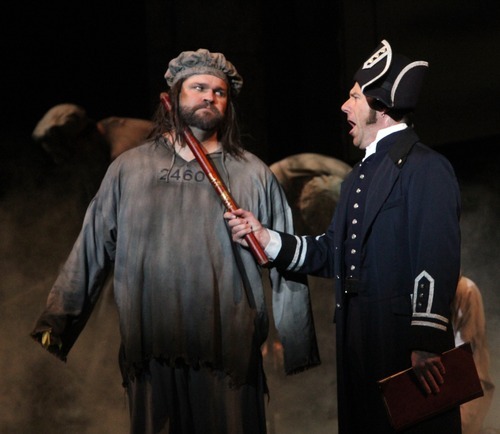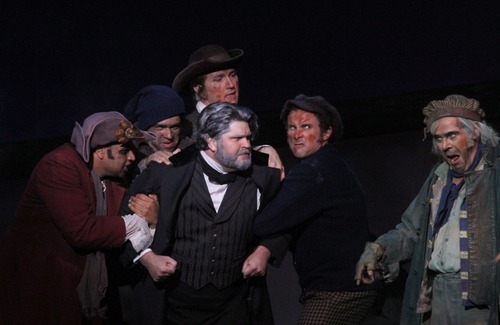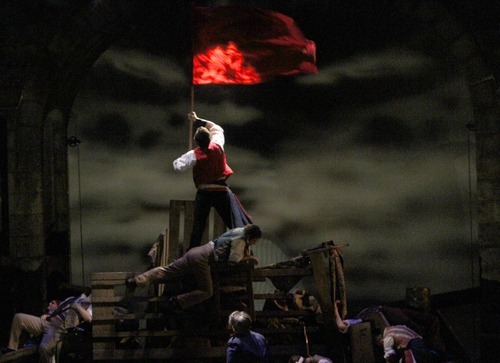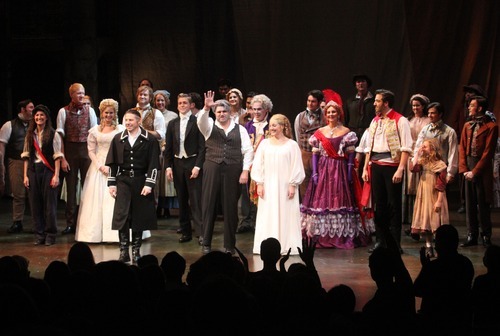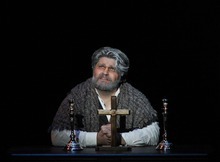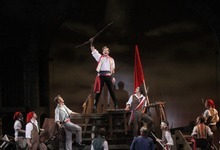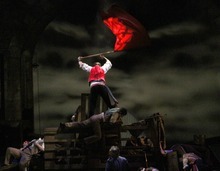This is an archived article that was published on sltrib.com in 2012, and information in the article may be outdated. It is provided only for personal research purposes and may not be reprinted.
The June Rebellion that hit 1832 Paris was a seismic date in French history. For Utah theater, it's safe to say that April 1991 was just as earth-shaking.
That's when "Les Misérables" swooped into Capitol Theatre for its first national tour through Salt Lake City, selling out in advance its entire 16-performance run.
Since then, the 1985 musical by Claude-Michel Schönberg and Alain Boublil — with its heart-in-throat soundtrack and Jean Valjean's redemptive journey — has defined Utah theater tastes and filled theater company coffers left, right and center.
The popular musical has, of course, captured the hearts and minds of audiences worldwide. It's now the third-longest-running show in Broadway history, topped only by "The Phantom of the Opera" and "Cats."
But "Les Misérables" holds Utah audiences virtual hostages in ways no other stage production can command. For 21 years and counting, it's a ransom we've paid with abandon — despite formidable ticket prices and repeated national and local productions.
—
Utah's 'Les Miz' effect • We've pounced on every seat for the show's nine national tours through Capitol Theatre, snatching up more tickets per capita than other comparable markets.
We lunged at every ticket for Pioneer Theatre Company's first-in-the-country regional production in 2007, when ticket sales erased the company's debt and allowed it to expand its offerings.
We scooped up tickets for five months running during Tuacahn Amphitheatre's 2008 run. Four years later, it remains the company's biggest grossing production.
And we're heading out in droves for Utah Shakespeare Festival's popular production of "Les Misérables" in Cedar City, where 96 percent of tickets already were spoken for as of early this month.
In the collective mind of theatergoing Utah, the setting of Paris in 1815-32 has transcended place and era to become a time-tested warhorse and the state's largest rainmaker.
Answers abound as to why the story of one man's moral education during Paris' street-fighting days affects Utah audiences in such a Pavlovian way. Some point to its spiritual themes and even historical affinities with the state's predominant faith, The Church of Jesus Christ of Latter-day Saints. Others cite its plot of a selfless man motivated by mercy and love of humanity.
But you can set aside the musical's supposed affinities with Utah cultural mores. It's simply a great musical, some theater people say, a testament to the talents of Schönberg, Boublil and producer Cameron Mackintosh.
"I've heard people say it's the second greatest story ever told, after general consensus that the first is the story of Christ," said Scott Anderson, Tuacahn's artistic director. "It's just incredibly well-written."
—
The power of redemption • It's fitting that a musical about one man's redemption has served its own redemptive effect on a handful of Utah's professional theater companies.
With scores of sold-out shows to prove its staying power, Utah theater professionals know it's foolhardy to underestimate the epic economic force of "Les Miz."
The musical has helped foster several professional theater companies in its wake and introduced at least two generations to live musical theater.
Almost 20 years after J. Michael Bailey saw his first production at Capitol Theatre, the Utah-based actor still talks about the 1993 show as one of the most significant theater experiences of his life. The work set him on a yearslong quest to play the central role, a goal he's reaching this season in Cedar City.
After years of attempting to tap into the musical's audience and revenue potential, the forces aligned for the Utah Shakespeare Festival this season.
"We definitely came down for 'Les Miz,' " said theatergoer Mandi Mendenhall, a Provo resident who casts actors for LDS Church films. "I like Shakespeare, too, but I'm too short on time to see those productions. I've always loved the show because it's inspiring and historical."
Tuacahn's Anderson had been familiar with the power that "Les Misérables" held over audiences ever since he saw a New York production in 1996. The theater professional, who also coached football for 30 years, saw it with three of his "jock friends" who had rarely entered a playhouse.
Two of his friends were moved to tears. "The friend of mine who didn't cry phoned his wife afterward to tell her how much he loved her," Anderson said. "Then he had to take her to see the show a year later."
In 2007, when Pioneer Theatre Company (PTC) announced it would be the first regional company in the nation to stage the musical, it sold more than $1.5 million in tickets before the cast was announced. A two-week run was extended to an unprecedented 10 weeks, earning a net revenue bonanza of $474,800.
Chris Lino, PTC's managing director, called the run "a shot of fiscal and season-ticket adrenaline," describing the musical as an anomaly in the nonprofit theater world. "Virtually all productions cost more to build and run than they generate in ticket sales," he said, "which is why not-for-profits have to fundraise."
Karen Azenberg, the company's new leader, was choreographer for the production under longtime artistic director Chuck Morey. "I'd never seen anything like it — people being that enthused and excited," Azenberg said of the musical's Utah appeal.
But the prospect of beaucoup bucks isn't reason enough to stage a production. Utah theater professionals, according to Brad Carroll, who is directing the current production at the Utah Shakespeare Festival, relish the challenge of producing a version worthy of a discerning fan base.
"It's the pinnacle of musicals, considering its size and scope," Carroll said, "not to mention audience expectation."
"Mizzies," as they're known, collect memories of various productions like butterflies. And no detail is too small.
"The innkeeper's towel was too short," said Katy Beukers, a registered nurse who traveled from Provo to see the Cedar City show during opening week in June. "If it was longer and lighter, it would have snapped better. Overall, though, it was a great performance."
—
Valjean meets Joseph • How could a musical set in France and abounding in revolutionary impulses have ever set red-state Utah afire? The short answer is that it appeals to our moral vision of the world. The longer answer may rest in its alluring music and stage scenery.
A prisoner for 19 years, Valjean lodges with the Bishop of Digne, the one man who helped him after his release. He steals from the bishop, but instead of exacting revenge, the bishop shows Valjean mercy. Valjean then makes it his life's endeavor to show others mercy, including the very policeman, Javert, who showed him none. He releases his life from past wrongs and keeps his promise to a dying prostitute that he will protect her daughter, Cosette.
Fortifying each scene is music ranging from heartfelt yearning ("I Dreamed a Dream") to rousing ("Do You Hear the People Sing?"). Topping it all off, the hero dies with his soul floating off to heaven, moments after his sacrifice is acknowledged.
With punishment as its subtext, "Les Misérables" has ethical and moral themes baked deep inside almost every scene. Actions and beliefs, the musical tells us, have consequence.
That message appeals greatly to Judge Thomas Willmore of Logan's 1st District Court. According to Logan's Herald Journal newspaper, the Cache County judge is fond of ordering criminal defendants to read Victor Hugo's epic novel and then write a report to help them reset their lives. The story gained national prominence recently on Huffington Post's culture blog, prompting the headline "What Would Jean Valjean Do?"
And when Utahns face ethical and moral dilemmas, speculation about religion is never far behind.
Eric Samuelsen, playwright and former professor of theater at Brigham Young University, posits that Utah audiences love "Les Misérables" in part because of its time period. In Paris, the fictional character of Jean Valjean suffered his travails parallel, more or less, to the time in America when Joseph Smith was founding the LDS faith.
"Valjean is imprisoned, but he's not really a criminal," Samuelsen said. "His crime was for the most minor of offenses, and his sentence seems preposterously disproportionate. I am reminded of Joseph Smith at Liberty Jail, held in prison on violation of habeas corpus. And Valjean prays. He gets the great song 'Bring Him Home,' which is a prayer. Mormons love that."
There are other parallels that LDS audiences might not be aware of, too, Samuelsen said. "It's also a show about social justice, which echoes Brigham Young and his excoriation of laissez-faire capitalism. But, of course, we're all capitalists now."
—
Mercy battles justice • Anderson finds that connection interesting. But it's a distant second, he believes, to the way the musical weaves tension out of the competing demands of justice and mercy.
The scene in which Javert dies in the Seine is central, Anderson said. Javert cannot reconcile his duty to uphold the law by arresting Valjean and returning him to prison because it's Valjean who saved his life. Justice, though compelling, holds no power over mercy. In desperation, Javert kills himself.
The scene is the key to understanding the interlocking power that resonates across the entire musical, Anderson said. "That scene plays out in everyone's soul," he said. "A theater lover understands that at a level that considers the acting and set design. That someone who doesn't understand theater at that level, but is also moved by it, is significant. That doesn't happen a lot."
Robert Nelson, a theater professor at the University of Utah, agrees with Samuelsen's point about the familiarity of the era for Utah audiences steeped in the religious fever of 1830s America. But Nelson contends the musical is popular among Beehive State audiences for a simpler reason: We crave a profanity-free musical with great songs and a hero everyone can root for.
There's just one problem, Nelson notes. "Its very accessibility is also its major challenge. Making everything so clear that all can understand it fully risks doing injustice to complex and personal issues. Life is rarely so simple."
Bailey would agree but in a turn-the-tables kind of way. Any perceived weakness in "Les Misérables," he would argue, is its strength.
"People complicate the show," he said. "It's not that complicated. It's about the rewards that come to the whole of a community because of the acts of one person.
"Also," he said, during the summer he's having the time of his theatrical life giving voice to Jean Valjean, "it's just great to see people smile when they come out of the theater."
bfulton@sltrib.comTwitter: @ArtsaltFacebook.com/nowsaltlake 'Les Misérables' at the Utah Shakespeare Festival
When • Through Oct. 19; playing in repertory with "The Merry Wives of Windsor," "Mary Stuart," "Titus Andronicus," "Scapin" and "To Kill a Mockingbird" through Sept. 1. Continues run with "Hamlet" and "Stones in His Pockets" Sept. 19-Oct. 20.
Where • On the campus of Southern Utah University, 315 W. Center St., Cedar City
Information • $22-$73; shows are selling out two or three weeks in advance, so visit http://www.bard.org or call 800-PLAYTIX or 435-586-7878 for availability. Utah and 'Les Miz' — By the numbers
Currently • By early August, Utah Shakespeare Festival's "Les Misérables" had sold more than 96 percent of its total run of tickets, with most shows selling out two weeks in advance, according to marketing director Kami Paul. That's higher than other comparably popular USF shows through the years, including another Utah favorite, "Joseph and the Amazing Technicolor Dreamcoat," which played the festival in 1998.
2008 •At Ivins' Tuacahn Amphitheatre, artistic director Scott Anderson was surprised to see the musical run at capacity, selling out the 1,920-seat stadium throughout its five-month run. "It really was something phenomenal," Anderson said. "By the time we finished, it was our largest-grossing production to date."
2007 • At Salt Lake City's Pioneer Theatre Company, a planned two-week run of 17 shows was extended to 10 weeks and 82 shows, earning the company more than $2.5 million in single-ticket sales, plus thousands of new season-ticket holders.The net revenue bonanza of $474,800 allowed the company to pay off its remaining debt, launch its New Plays Initiative and put the funding cap on a building to house visiting actors, Meldrum House, which opened last year. The company will reprise its production May 3-June 1, under former choreographer Karen Azenberg, PTC's new artistic director.
1991-2003 and 2011 • For national touring shows, "Les Misérables" repeatedly sold nearly every seat in the 1,900-seat Capitol Theatre. The musical set sales records well beyond the expected capacity of Salt Lake City's market size.



